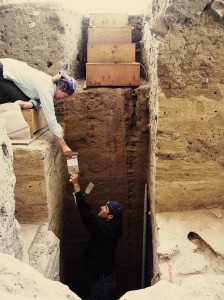 Then–graduate student Bradley A. Newbold (BA ’05) and UNLV master’s student Sara Hill collect pollen samples from the North Creek Shelter in Escalante Valley, Utah’s oldest site known to have been occupied by humans. Here, BYU archaeologist Joel C. Janetski (BA ’65) and a team of students found stone tools that suggest there was a change in the menu 10,000 years ago. The appearance of grinding tools around 8,000 B.C. shows that people began grinding seeds into flour more and eating certain animals less. Janetski attributes this to a change in climate, confirmed by the sediment studies of geology professor Thomas H. Morris (BS ’81) and graduate student Tanner C. Hicks (BS ’08). After five summers excavating the North Creek Shelter, the group will publish its findings in the upcoming issue of the journal Kiva. Then–graduate student Bradley A. Newbold (BA ’05) and UNLV master’s student Sara Hill collect pollen samples from the North Creek Shelter in Escalante Valley, Utah’s oldest site known to have been occupied by humans. Here, BYU archaeologist Joel C. Janetski (BA ’65) and a team of students found stone tools that suggest there was a change in the menu 10,000 years ago. The appearance of grinding tools around 8,000 B.C. shows that people began grinding seeds into flour more and eating certain animals less. Janetski attributes this to a change in climate, confirmed by the sediment studies of geology professor Thomas H. Morris (BS ’81) and graduate student Tanner C. Hicks (BS ’08). After five summers excavating the North Creek Shelter, the group will publish its findings in the upcoming issue of the journal Kiva.
Then–graduate student Bradley A. Newbold (BA ’05) and UNLV master’s student Sara Hill collect pollen samples from the North Creek Shelter in Escalante Valley, Utah’s oldest site known to have been occupied by humans. Here, BYU archaeologist Joel C. Janetski (BA ’65) and a team of students found stone tools that suggest there was a change in the menu 10,000 years ago. The appearance of grinding tools around 8,000 B.C. shows that people began grinding seeds into flour more and eating certain animals less. Janetski attributes this to a change in climate, confirmed by the sediment studies of geology professor Thomas H. Morris (BS ’81) and graduate student Tanner C. Hicks (BS ’08). After five summers excavating the North Creek Shelter, the group will publish its findings in the upcoming issue of the journal Kiva. Then–graduate student Bradley A. Newbold (BA ’05) and UNLV master’s student Sara Hill collect pollen samples from the North Creek Shelter in Escalante Valley, Utah’s oldest site known to have been occupied by humans. Here, BYU archaeologist Joel C. Janetski (BA ’65) and a team of students found stone tools that suggest there was a change in the menu 10,000 years ago. The appearance of grinding tools around 8,000 B.C. shows that people began grinding seeds into flour more and eating certain animals less. Janetski attributes this to a change in climate, confirmed by the sediment studies of geology professor Thomas H. Morris (BS ’81) and graduate student Tanner C. Hicks (BS ’08). After five summers excavating the North Creek Shelter, the group will publish its findings in the upcoming issue of the journal Kiva.
BYU Today






